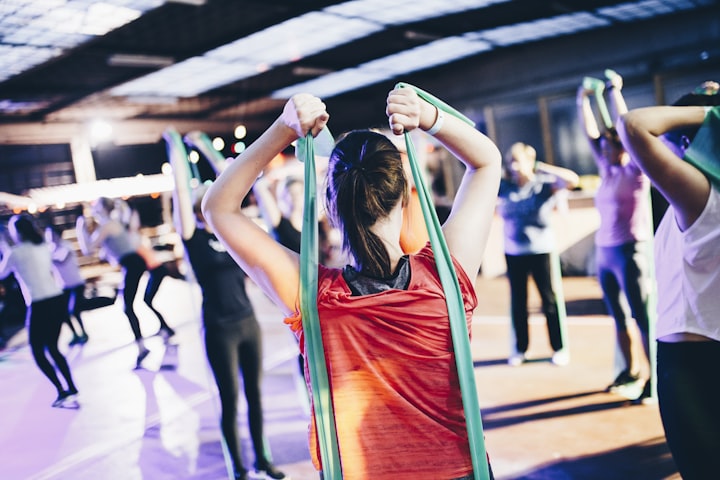
Intro
Are you looking for a way to add variety and challenge to your fitness routine? Exercise resistance bands with handles can provide the perfect solution!
These versatile and affordable pieces of equipment can give you an effective full-body workout, working muscles that are often ignored when using traditional weights. They can also help you to build core strength and improve your balance.
In this blog post, we’ll explore why you should include exercise resistance bands with handles in your fitness routine.
Benefits of Using Exercise Resistance Bands with Handles
Exercise Resistance Bands with Handles are an effective way to get a full-body workout without the need for heavy equipment or weights. Here are some benefits of incorporating Resistance Bands into your fitness routine:
1. Versatility - Resistance Bands can be used for a variety of exercises, including squats, lunges, curls, and presses. They can be used alone or incorporated into a workout with weights to increase the resistance.
2. Portability - Resistance Bands are lightweight and can be easily transported, making them perfect for working out on the go. You can take them with you to the park, the gym, or even on vacation.
3. Low Impact - Resistance Bands are a low-impact workout option, making them ideal for those with joint pain or injuries. They offer a full-body workout without putting stress on the joints.
4. Scalability - Resistance Bands come in different resistance levels, making them perfect for people of all fitness levels. Beginners can start with lower resistance and gradually increase as they get stronger.
Incorporating Exercise Resistance Bands with Handles into your fitness routine can lead to improved strength, flexibility, and overall fitness. Plus, they're a fun and effective way to switch up your workouts and challenge your muscles.
Types of Exercise Resistance Bands with Handles
There are various types of exercise resistance bands with handles that you can choose from based on your fitness level and preferences. Here are the most common types of resistance bands with handles:
1. Tube Resistance Bands: These are the most popular type of exercise resistance bands with handles. They come in various resistance levels and are perfect for toning and strengthening your muscles.
2. Flat Resistance Bands: These bands are thin and flat, and they offer resistance when stretched. They are ideal for low-impact exercises such as Pilates, yoga, and stretching.
3. Loop Resistance Bands: These bands are closed loops that can be used for both upper and lower body exercises. They come in different resistance levels and are perfect for building strength, endurance, and flexibility.
4. Figure 8 Resistance Bands: These bands are shaped like the number 8 and are ideal for upper body exercises such as bicep curls and shoulder presses. They offer different resistance levels and are perfect for beginners.
When choosing the right resistance band with handles, it is important to consider your fitness level, the type of exercise you want to do, and the resistance level that is suitable for your strength. Always choose a high-quality resistance band with handles to ensure your safety during your workout.
How to Choose the Right Resistance Band
Choosing the right resistance band with handles is crucial for ensuring an effective and safe workout. Here are some factors to consider when selecting the perfect resistance band for your fitness routine.
1. Resistance Level: Resistance bands come in different levels of resistance, typically indicated by colour or tension strength. Beginners should start with a lighter resistance band and gradually progress to higher levels as their strength improves. It is important to choose a resistance level that challenges your muscles without causing strain or injury.
2. Length and Size: Resistance bands come in various lengths and sizes. Longer bands provide more versatility and allow for a wider range of exercises, while shorter bands are better suited for exercises that require less movement. Consider the length of the band and how it aligns with the exercises you plan to do.
3. Material and Durability: Look for resistance bands made from high-quality materials that can withstand regular use. Bands made from natural latex or fabric are typically more durable and less likely to snap or break during workouts.
4. Comfort and Grip: The handles on resistance bands should be comfortable to hold and provide a secure grip. Look for bands with ergonomic handles that prevent slipping or discomfort during use. The handles should also be large enough to accommodate your hands comfortably.
5. Purpose and Exercise Selection: Consider the type of exercises you plan to do and choose a resistance band that is suitable for those specific movements. Tube resistance bands with handles are great for overall strength training, while loop bands are better for lower body exercises like squats and glute bridges.
By considering these factors, you can choose the right resistance band with handles that suits your fitness level, goals, and exercise preferences. Remember to consult with a fitness professional if you're unsure about which resistance band is best for you.
Top Resistance Band Exercises for a Full-Body Workout
Resistance bands are a versatile and convenient piece of equipment that can be used for a full-body workout. Here are some top exercises to try:
1. Bicep curls: Stand on the band with your feet shoulder-width apart, holding the handles at your sides. Slowly curl the bands up towards your shoulders, keeping your elbows close to your body.
2. Squats: Place the band under your feet and hold the handles at your shoulders. Lower yourself into a squat position while keeping your chest up and back straight. As you stand up, press the bands overhead.
3. Chest press: Anchor the band to a sturdy object at chest height. Hold the handles and face away from the anchor point, then slowly push the handles forward until your arms are extended. Bring the handles back towards your chest, keeping your elbows close to your body.
4. Triceps extensions: Hold the band behind your back, one handle in each hand. Extend your arms up towards the ceiling, keeping your elbows close to your head.
5. Lateral band walk: Place the band around your legs just above your knees. Stand with your feet hip-width apart and take small steps to the side, keeping tension in the band.
These exercises can be modified for different fitness levels by adjusting the tension of the band and the number of repetitions. Remember to warm up before starting your workout and to stretch afterwards to prevent injury.
Tips for Effective Resistance Band Training
1. Choose the Right Band: Make sure to select a resistance band with the right amount of tension for your fitness level and the exercise you want to perform. Start with a lower resistance band and gradually increase the intensity as your strength improves.
2. Warm-up: Before starting your resistance band workout, perform a 5-10 minute warm-up routine to loosen up your muscles and get your blood flowing.
3. Correct Form: It is important to maintain correct form while using resistance bands. Keep your back straight, engage your core, and focus on the muscle you are working.
4. Variety: To avoid boredom and to target different muscles, vary your resistance band exercises. There are many different exercises you can perform with resistance bands, including bicep curls, shoulder presses, squats, and lunges.
5. Time Under Tension: To maximise the benefits of your resistance band workout, focus on time under tension. This means slowing down your movements and holding each rep for 1-2 seconds before releasing.
6. Consistency: To see results, consistency is key. Aim to perform resistance band workouts 2-3 times per week and gradually increase the intensity over time.
7. Cool-down: After your resistance band workout, perform a cool-down routine to stretch your muscles and reduce soreness.
By following these tips, you can effectively incorporate exercise resistance bands with handles into your fitness routine and achieve your fitness goals.
If you want a great way to exercise your body, click here





Comments (1)
Super support my articles